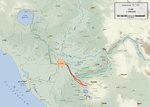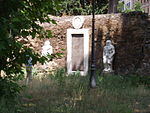Teatro Ambra Jovinelli
Art Nouveau theatresEuropean theatre (structure) stubsItalian building and structure stubsTheatres completed in 1909Theatres in Rome

The Teatro Ambra Jovinelli (literally "Ambra Jovinelli Theater"), formerly known just as Teatro Jovinelli, is a theatre located in Rome, Italy. It was founded by the theater organizer Giuseppe Jovinelli, who intended to build a theater devoted to variety and comic representations which had a luxurious face and which appeared stylistically rich and noble.Built in the ancient Esquilino quarter, construction work began in 1906 and the inauguration took place in 1909.
Excerpt from the Wikipedia article Teatro Ambra Jovinelli (License: CC BY-SA 3.0, Authors, Images).Teatro Ambra Jovinelli
Via Guglielmo Pepe, Rome Municipio Roma I
Geographical coordinates (GPS) Address Phone number Website External links Nearby Places Show on map
Geographical coordinates (GPS)
| Latitude | Longitude |
|---|---|
| N 41.8956 ° | E 12.508 ° |
Address
Teatro Ambra Jovinelli
Via Guglielmo Pepe 43
00185 Rome, Municipio Roma I
Lazio, Italy
Open on Google Maps









